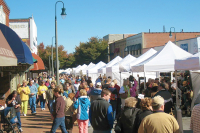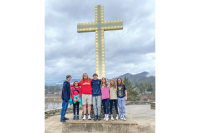Kephart's life after Hazel Creek
Horace Kephart left the cabin site on the Little Fork in the fall of 1907, spending considerable time in other areas of the Southern Appalachians, comparing life there with what he had observed here in the mountains of Western North Carolina. Upon his return to the Smokies in 1910, the W.M. Ritter Lumber Company had commenced operations on Hazel Creek. Not wanting to live among that sort of activity, he moved into the Cooper House, an unpretentious boarding just off the town square in Bryson City. He also rented a small office space over the old Bennett’s Drug Store just around the corner.
In Bryson City, Kephart had access to a far different style of mountain life than he had pursued along Hazel Creek from 1904 to 1907: the leisurely ebb and flow of village life, which quickened only at election time or certain holidays or during court week, itself a sort of holiday.
As his fame grew after the publication of Our Southern Highlanders, Kephart found refuge from summer visitors seeking him out by camping at the old Bryson Place, now a designated camping area in the national park situated about 10 miles north of Bryson City alongside Deep Creek. He would sometimes go there for an entire summer, hauling in by wagon or on horseback the supplies and equipment he required, which included a small folding desk and writing materials. While there, he also tested firearms and camping equipment — materials on which he was a recognized national authority — for various companies. Present-day visitors to Bryson Place will find a millstone with a plaque commemorating his use of the site.
It would be wrong, however, to suppose that Kephart was an aloof loner. He had many friends, including George Masa, the great Japanese photographer. And he took part in the civic affairs of Swain County and Bryson City, being a member of the county’s Chamber of Commerce and an elected chairman of the town’s Board of Alderman. I have been told that he instigated the construction of the first sidewalks and streetlights in Bryson City.
The Great Smoky Mountains National Park, wasn’t officially founded until 1934, three years after his death. But he died knowing that the park was going to be a reality. Several of the details surrounding Kephart’s death are peculiar.
Related Items
On April 2, 1931, at the age of 68, Kephart was killed in an automobile accident east of Bryson City. A friend, the Georgia writer Fiswoode Tarleton, who was staying with Kephart for a few weeks, was also killed. Tarleton was the author of a book about mountain life titled Bloody Ground, a cycle of 12 stories set in the fictional town of Leeston. For whatever reason, he was buried in a plot near Kephart’s gravesite in a cemetery overlooking Bryson City rather than in Georgia.
It is widely known that Kephart and Tarleton had hired a taxi cab driver to take them to a bootlegger near Cherokee. They were on their way back to Bryson City when the driver lost control of the car in a curve. It has been alleged that the driver was also imbibing. Kephart was buried three days after the accident, with his two sons and a grandson in attendance.
In 1994, Swain County native Wilma Ashe prepared for me a typed description of the accident scene:
“My cousin, Eugene, was giving me a ride to my home in Whittier after senior play practice at Swain High School. It was about 11 p.m. In front of Oscar Cline’s residence in Ela (at the mouth of Coopers Creek) the flicker of a small flashlight was being swung beside the road by Oscar’s wife, Sally. We were the first car to stop and discovered it was a car overturned. With the light from our car and Sally’s flashlight, we could see bodies pinned in the car. They were silent! The first man pulled out was Mr. Brown, the taxi driver. He could not speak but was breathing and alive. We stretched his body out on the side of the road and quickly turned to the wrecked car. There was a body pinned between the car and the bank. It took all three of us pulling and lifting to move the car off his body and pull it out to the roadside. We realized there was no life. He had no visible injuries. I remarked ‘I’ve seen this man before, I think I know him.’ I opened his jacket front and in his breast pocket was a letter addressed to ‘Horace Kephart.’ I said ‘Oh, that’s who it is!’ We looked up as a car that had stopped was pulling off into the road. It was too far for us to reach Mr. Brown, who was swinging on the spare tire on the rear of the car. They went out of sight. I never heard of him anymore or the details. We returned to the next victim in the car. He was a huge man [and] had no doubt died instantly ….
“The funeral was held for these two victims at the Swain High School auditorium on the following Sunday afternoon. All the churches took part in the service. That was 63 years ago. I had just had my 17th birthday, but I remember I was asked to serve as an usher. The auditorium was filled to capacity. No doubt this was the biggest and greatest funeral ever held in Bryson City.”









